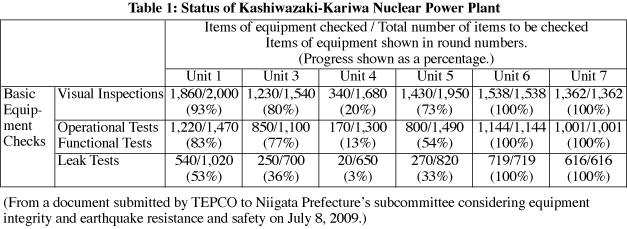KK Nuclear Power Station 2 Years After the Chuetsu-oki Earthquake
July 16 was the second anniversary of the Chuetsu-oki Earthquake. The seismic force that struck Tokyo Electric Power Company's (TEPCO) Kashiwazaki-Kariwa Nuclear Power Station (KK) was unprecedented in the history of nuclear power.
Start-up testing of KK-7 (ABWR, 1356 MW) began on May 8 (see NIT 130) and commercial operations were expected to begin at the end of July. However, on July 23 a leak of radioactive gas caused this schedule to be delayed. Elevated levels of radioactive xenon gas were recorded at the off gas monitor.
KK-6, which is the same type and size as KK-7, is in the final stage before start-up tests. Preparations to restart the other five reactors (all BWRs) are not so advanced. This article discusses the situation regarding all seven KK nuclear power plants.
In the process of bringing Unit 7 up to full power, 75 problems were identified. TEPCO has only published details of eight of these problems. TEPCO's explanations were accepted by the Nuclear and Industrial Safety Agency (NISA) and Niigata Prefecture's technical review committee. The governor of Niigata Prefecture is expected to give his final judgment soon. These approvals are based on the premise that the problems identified do not represent a safety risk. However, since details of 67 of the problems have not been made public, citizens are not in a position to judge whether or not the plant is safe.
The Niigata Prefecture office responsible for nuclear safety boasted that its top priority was the safety and peace of mind of the citizens. However inconsistency has arisen between the approaches of the prefecture and the central government in regard to assessment of equipment integrity and seismic resistance as well as the process by which citizens' concerns are addressed. The central government requires that equipment integrity be assessed in accordance with the following process:
1) assessment of equipment one item at a time;
2) assessment at a system level;
3) assessment of the plant as a whole.
This process has been completed for KK-7 and an overall report was submitted on June 29.
Table 1 shows the state of progress of equipment integrity assessments as of July 8 for each of the seven KK plants (TEPCO report). Visual inspections, operational tests, functional tests and leak tests have all been completed for Units 6 and 7. The next most advanced is Unit 1. After the earthquake TEPCO said that it would inspect Units 1 and 7 in parallel, but as can be seen, that plan has gone by the board. Progress on Unit 4 is woeful, while Unit 2 is not even shown in this table. When the Chuetsu-oki Earthquake struck, Unit 2 was in the process of being started up, while Units 3, 4 and 7 were operating at full power. The other units were closed for inspections. In a note below the table TEPCO states that visual inspections of Unit 2's safety important equipment, including core internals and control rods, have been completed, but that it is not yet in a position to provide quantitative data.
As of the end of July, Unit 6 was on the verge of beginning start-up tests. NISA accepted TEPCO's assessment, including its seismic safety assessment, and at the end of June agreed that TEPCO could proceed to restart the plant. The subcommittee established by Niigata Prefecture to look into equipment integrity and earthquake resistance and safety accepted this at its 23rd meeting, held on July 9, but at its next meeting, held on the same day as the radioactive gas leak from KK-7, the subcommittee reviewed this decision. In the end, the original decision was confirmed, but it was agreed that the dissenting views of two subcommittee members would be recorded in the final report. The next step is for Niigata Prefecture's technical review committee to give its approval. Finally, the governor must give his approval for the restart. Had there not been a radioactive leak, it was expected that he would have given his approval on July 24.
On July 14, citizens' groups held negotiations with the prefecture concerning approval of commercial operation of Unit 7. During the negotiations the prefecture was unable to answer several safety-related questions posed by "Niigata Citizens' Committee to Protect Our Lives and Home Towns from Nuclear Power". Besides these unresolved questions, serious questions were raised about the mode of operation of Niigata Prefecture's technical review committee.
During the negotiations the "Three Local Anti-Nuclear Groups" pointed out errors in TEPCO's report about the geology of the Kashiwazaki Plain. It is possible that TEPCO's assessment will be shown to be fundamentally flawed. Niigata Prefecture has been forced to review the issue. On July 24 it reconvened the subcommittee looking into the Chuetsu-oki Earthquake and ground condition.
At the earliest, KK-7 could begin commercial operations around August 10, but due to the leak of radioactive gas and the problems identified by the local anti-nuclear groups, the start of commercial operations could be delayed longer. In the meantime, KK-7 is continuing test operations at low power. It is not certain what impact this will have on the schedule for beginning test operations at Unit 6, but it has become more difficult for Niigata Prefecture to ignore the concerns of the local residents.
Yukio Yamaguchi (CNIC Co-Director)


